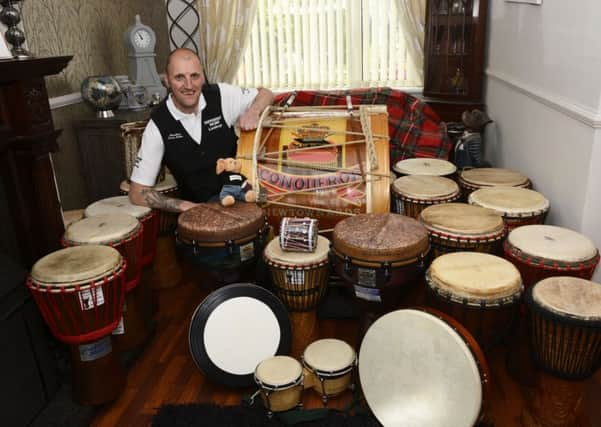Marching to a different beat


“My God, he can even drum with a set of matchsticks,” said the granny.
It must have been in the blood - he’s related to the Gene Krupa of the Fountain, Jackie Molloy, after all - so maybe that’s where he gets it from.
Advertisement
Hide AdAdvertisement
Hide Ad“I was sitting in my granny’s house waiting for our breakfast to come in and there used to be a box of matches, the Swan matches, and the next thing was, my granny was saying, ‘My God, I don’t believe it, he’s sitting there drumming with a pair of matchsticks.’”


It was perhaps inevitable the ancient art of drumming would form such a major part of Alan’s life.
He’s now amassed a huge collection of largely traditional drums ranging from the lambeg and bodhrán, to the West African djembe; he’s even assembled an entire Brazilian samba bateria.
He recently formed the Different Skins drumming project and tours the city and further afield imparting his knowledge and enthusiasm for traditional drumming to all comers, using it to break down barriers and as a way of improving the self-esteem of disadvantaged young people and those with learning disabilities and other conditions.
Advertisement
Hide AdAdvertisement
Hide AdBut it all began back in the granny’s kitchen with the box of Swans and it soon took off from there.
“Away back in the safari park in Portrush many years ago, there used to be an African drum and I bought one of these ornaments, these African drums, it so happened that the day I bought it I began to play it and play it and play it. I think I was only eight or nine.
“Later, I joined bands and stuff like that. I just got on to the old tradition, the old bodhráns and the likes of the lambegs and the djembes.
“I eventually joined bands, the Hamilton band and so forth.
“A man called Jim Parkhill taught me a brave bit of drumming, music drumming and all that.”
Advertisement
Hide AdAdvertisement
Hide AdAlan soon began to take a deeper interest in the traditional drumming of Ulster.
Although there is no great lambeg tradition in the Londonderry area his interest in the drum was piqued by a scene painted by a man from the Fountain, which showed a crowd behind a couple of lambeg drummers in the old Fountain Street years ago.
“I’d always an interest in the lambeg. I always wanted a lambeg because I like to share culture with other people, to let people see why music should be played,” he explains.
“The word respect comes into play, to respect other cultures. When you take the bodhrán and lambeg, when I go into a secondary school, I let them see exactly what the old traditional drums were like.
Advertisement
Hide AdAdvertisement
Hide Ad“What they done was they celebrated and used these drums with fifes. There are only two instruments you can play with the lambeg - the pipes and the fife flute.
“There’s no other instrument would be strong enough to hear along with the sound of that drum there. The sound of that drum there would be very loud.
“That’s where you get the old tradition. The drums have gotten smaller. They’ve used the old tradition, made them smaller, to make them easier to carry.”
The drum he’s referring to is one of five lambegs he now owns, three of which he keeps in Londonderry with two others up the country to save on the logistical problem of transportation when he has gigs or engagements in the east of the province.
Advertisement
Hide AdAdvertisement
Hide AdThe ‘Crown Conqueror’ from Newtownards - like Alan’s other lambegs, came from the famous W&J Hamilton family workshop in Carrickfergus.
“He can go out the front door but that’s the only way he can go!” says Alan. “That’s one of the biggest drums in this city. There wouldn’t be a bigger drum. The Mem [Apprentice Boys of Derry Memorial Hall] might have had a drum leant to them for the museum but there’s no lambegs that size in the city at all.
“That there is 100 years old.
“You know by the names on the drum, you know by a stamp on the skin. People think you could just change the skin but it’s not as easy as that. If you look inside there are two holes and inside this shell that stamp will be inside the timber as well.”
Alan’s aware its a tradition steeped in history.
“In County Monaghan back at the time of the Battle of the Boyne young soldiers sat in the hedges, these drums were used to fight the armies of James.
Advertisement
Hide AdAdvertisement
Hide Ad